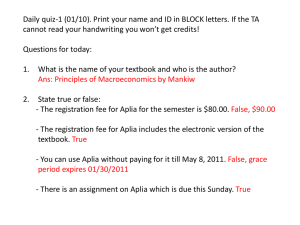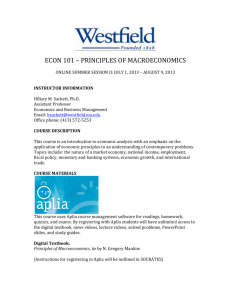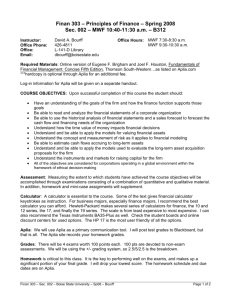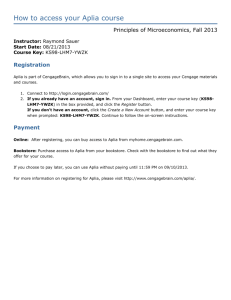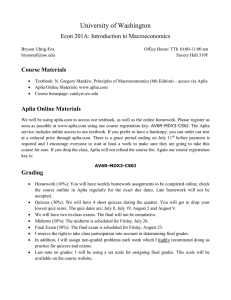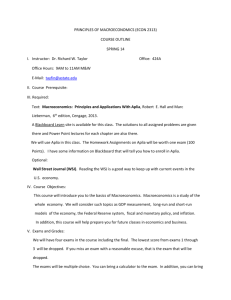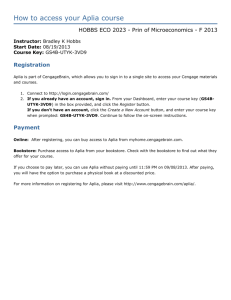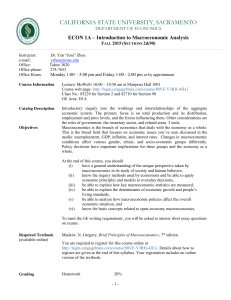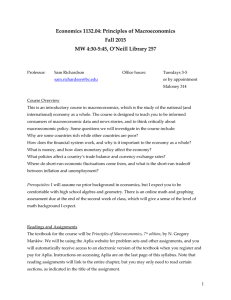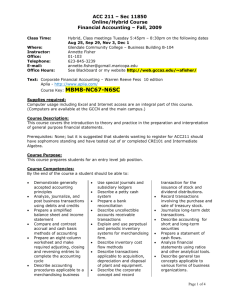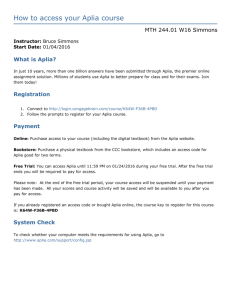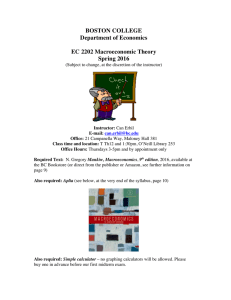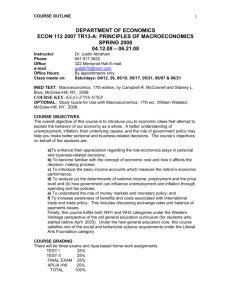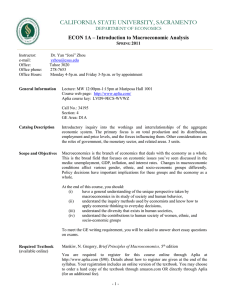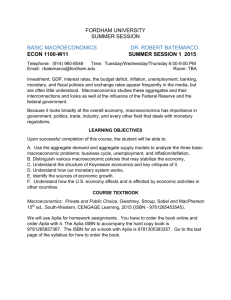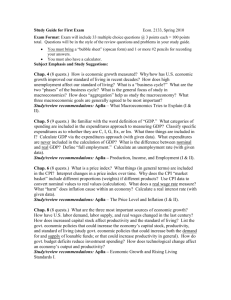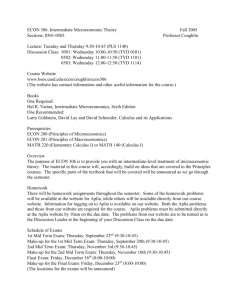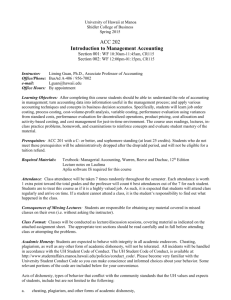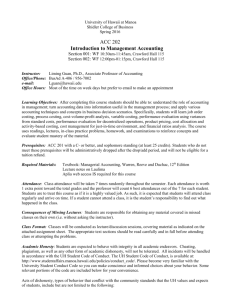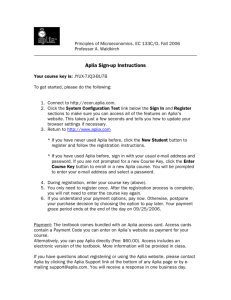Econ 201 - Principles of Macroeconomics Autumn 2013
advertisement
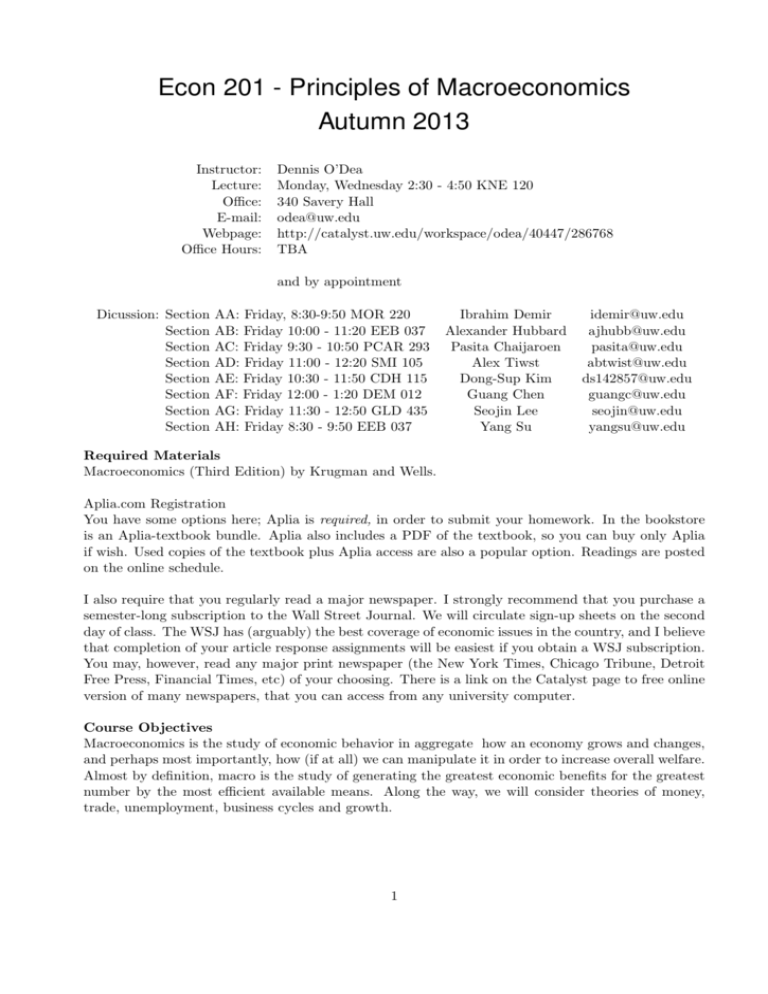
Econ 201 - Principles of Macroeconomics Autumn 2013 Instructor: Lecture: Office: E-mail: Webpage: Office Hours: Dennis O’Dea Monday, Wednesday 2:30 - 4:50 KNE 120 340 Savery Hall odea@uw.edu http://catalyst.uw.edu/workspace/odea/40447/286768 TBA and by appointment Dicussion: Section Section Section Section Section Section Section Section AA: Friday, 8:30-9:50 MOR 220 AB: Friday 10:00 - 11:20 EEB 037 AC: Friday 9:30 - 10:50 PCAR 293 AD: Friday 11:00 - 12:20 SMI 105 AE: Friday 10:30 - 11:50 CDH 115 AF: Friday 12:00 - 1:20 DEM 012 AG: Friday 11:30 - 12:50 GLD 435 AH: Friday 8:30 - 9:50 EEB 037 Ibrahim Demir Alexander Hubbard Pasita Chaijaroen Alex Tiwst Dong-Sup Kim Guang Chen Seojin Lee Yang Su idemir@uw.edu ajhubb@uw.edu pasita@uw.edu abtwist@uw.edu ds142857@uw.edu guangc@uw.edu seojin@uw.edu yangsu@uw.edu Required Materials Macroeconomics (Third Edition) by Krugman and Wells. Aplia.com Registration You have some options here; Aplia is required, in order to submit your homework. In the bookstore is an Aplia-textbook bundle. Aplia also includes a PDF of the textbook, so you can buy only Aplia if wish. Used copies of the textbook plus Aplia access are also a popular option. Readings are posted on the online schedule. I also require that you regularly read a major newspaper. I strongly recommend that you purchase a semester-long subscription to the Wall Street Journal. We will circulate sign-up sheets on the second day of class. The WSJ has (arguably) the best coverage of economic issues in the country, and I believe that completion of your article response assignments will be easiest if you obtain a WSJ subscription. You may, however, read any major print newspaper (the New York Times, Chicago Tribune, Detroit Free Press, Financial Times, etc) of your choosing. There is a link on the Catalyst page to free online version of many newspapers, that you can access from any university computer. Course Objectives Macroeconomics is the study of economic behavior in aggregate how an economy grows and changes, and perhaps most importantly, how (if at all) we can manipulate it in order to increase overall welfare. Almost by definition, macro is the study of generating the greatest economic benefits for the greatest number by the most efficient available means. Along the way, we will consider theories of money, trade, unemployment, business cycles and growth. 1 The exams are tentatively scheduled as follows: • Midterm I: Chapters 1-3, 6 - Wednesday, October 16 • Midterm II: Chapters 7-11 - Wednesday, November 13 • Final Exam: Chapters 12-16 - Tuesday, December 10, 2:30-4:20pm, KNE 120 Each exam, including the final, accounts for 25% of your final grade. Homework We will use the online homework system Aplia in this course. You must purchase access to Aplia to submit your homework. Homework will be due the Monday of each week, exluding the weeks following an exam. Your average score on the homework accounts for 11% of you final grade. Participation Beginning the second lecture, we will use Turning Point clickers for in-class participation; starting the fourth lecture, we will record your responses, and these responses will count towards participation in the course. So you need to get a clicker and register it online by the fourth lecture of the course. I will ask a number of questions in each lecture. Each days participation will have the same value towards your final grade. I assign points for both participation and correctness, but most points - around 80% - are for simple participation. We will drop your 5 lowest daily scores, meaning you can miss that many days with no grade penalty. This drop policy covers participation that was not observed for any reason, including (but not limited to) malfunctioning clickers and absences due to sports, job interviews, or illness. The remainder of the points are for getting questions correct. This will account for 5% of your final grade. Article Response You will submit three article responses over the semester. For each, you will find a news article from a major newspaper or periodical (either in its physical format or online incarnation) that 1) was written after the previous response was due, and 2) relates to a course topic taught after the previous response was due. We will not accept articles from aggregators (Google, Yahoo, AP feeds, etc), nor from blogs or opinion pieces, even if they are hosted on news sites. You must describe, in your own words, the issues presented in the article, and then summarize how the material taught in class explains the information, events, or phenomenon in the article. This economic explanation must relate to a theoretical graph (one with some sort of equilibrium, like Supply and Demand, the PPF, etc). The graph must be drawn and included in your response. You must submit your response and the article (in physical form) to your TA in the discussion indicated by the schedule. Late responses are not accepted. The written component of the response should be no longer than one page (of 12-point, 1.5 spaced writing) long. Be brief! Responses will be evaluated in a very simple manner, out of 5 points. 5 Points: Successfully and correctly a) summarizes the article (gets the facts right), b) assess the relationship between the article and the textbook, c) includes a classroom theoretical, analytical graph illustrating the policy or event described in the article. 4 Points: Didn’t do one of the things necessary for a 5-point answer correctly 3 Points: Didn’t do two of the things necessary for a 5-point answer correctly 2 Points: Write-up is not satisfactory, but the article is from the relevant time period, and addresses a topic from the relevant portion of the course 1 Point: Write-up is not satisfactory, and the article does not cover relevant issues 2 0 points: No response submitted. This will account for 9% of your final grade. They will be due Friday October 11, Friday November 8, and Friday December 6. Grade Scheme • Exams: 25% each. • Homework: 11% • Participation: 5% • Article Response 9% You grade average will be calculated according to the above scheme. Your final grade will be based on this tentative grading scheme. What is tentative are the percentages in the left hand column; they may be adjusted downwards. So, for example, an 84 will certainly be at least 2.9, and may end up being higher, but not lower. Percentage 94-100 90-93 87-89 84-86 Letter Grade Equivalent A AB+ B Numeric Grade-Point 3.9-4.0 3.5-3.8 3.2-3.4 2.9 -3.1 80-83 77-79 74-76 70-73 BC+ C C- 2.5-2.8 2.2-2.4 1.9-2.1 1.5-1.8 67-69 64-66 60-63 Below 60 D+ D DF 1.2-1.4 0.9-1.1 0.7-0.8 0.0-0.6 Student Athletes If you are a student athlete, inform me a.s.a.p. of interferences with your commitments as an athlete (especially conflicts with exam dates). You will be expected to bring in a letter from the athletics department. The sooner you notify me, the better that I will be able to accommodate you. Academic Accommodations The University of Washington is committed to providing access and reasonable accommodation in its services, programs, activities, education and employment for individuals with disabilities. For information or to request disability accommodation contact: Disability Resources for Students (Seattle campus, matriculated students) at (206) 543-8924/V, (206) 543-8925/TTY, (206) 616-8379 (FAX), or e-mail at uwdss@uw.edu Academic Integrity Academic integrity is the cornerstone of the Departments rules for student conduct and evaluation of student learning. Students accused of academic misconduct will be referred directly to the Office of Community Standards and Student Conduct for disciplinary action pursuant to the Student Conduct Code and, if found guilty, will be subject to sanctions. Sanctions range from a disciplinary warning, 3 to academic probation, to immediate dismissal for the Department and the University, depending on the seriousness of the misconduct. Dismissal can be, and has been, applied even for first offenses. Moreover, a grade of zero can be assigned by the instructor for the course. 4 Miscellaneous Rules Calculators: There will be numerical questions on the exams. You will want to use a scientific calculator on the exams, but you may only use ones that are non-programmable. This rule excludes the use of most graphing calculators the graphing functions will never be useful, and the incentive to use them to cheat is too great. You may NOT use your cell phones, Blackberries, PDAs, or any other multi-purpose electronic devices for their calculator functions. Devices in Class: Silence your cell phones, pagers, and whatever else you have that makes noise. Despite what you think, it is very obvious when youre watching YouTube in class. Please consume your media elsewhere than in class its distracting to me, and to your peers around you. I reserve the right to ban all laptops from the class if this becomes an issue. Food: Please refrain from eating in class, especially from eating Peanut-based foods, out of respect for your classmates who are allergic. 5
